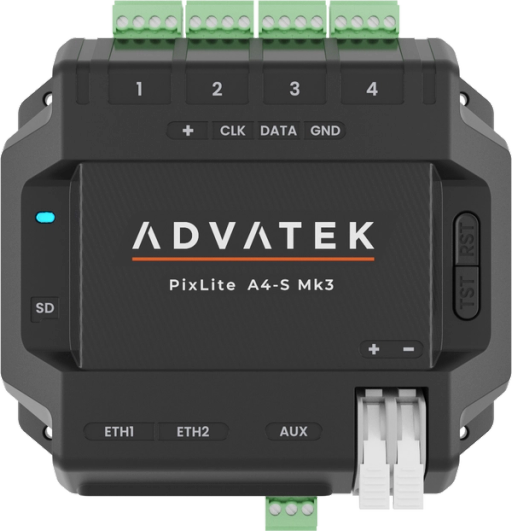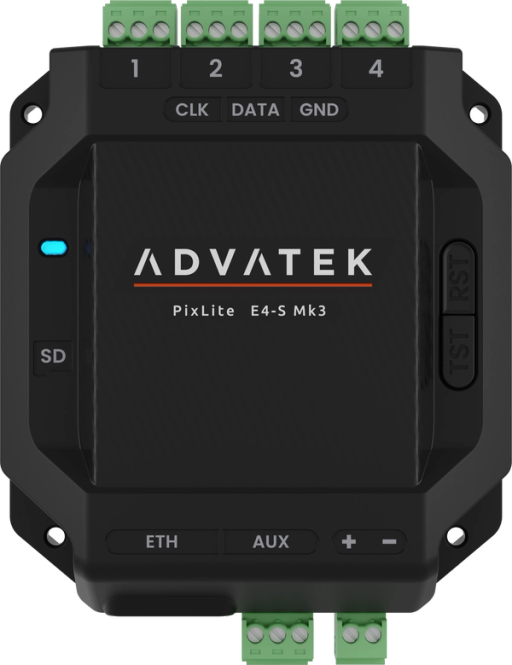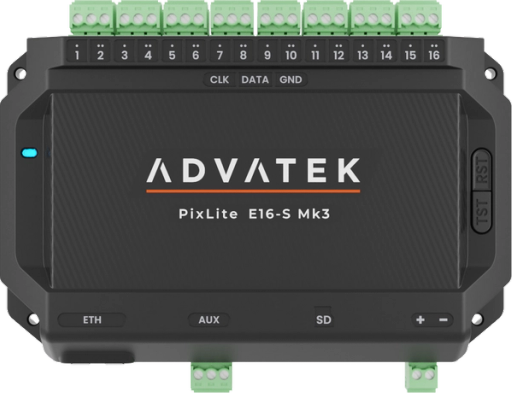Overview
This pixel protocol was designed by Genesis-Systech in China. While the features are very similar to GS8206, GS8208 also allows for a constant current pixel system, via a series LED connection. This results in a more stable lighting system. The control circuit comes in a SOP8 package, allowing for more flexibility with LED choice.
Current Control
GS8206 has the ability to digitally control the current of the connected LEDs. Use the 2-bit global current control to lower the brightness without sacrificing resolution. This global brightness control can be set when configuring your PixLite Mk3 controller.

GS8208 pixel protocol
Note: Advatek Lighting is in no way affiliated with Genesis-Systech.
Specifications
PixLite Mk1 | |
PixLite Mk2 | |
PixLite Mk3 | |
Clock Type | Data-Only |
Color Resolution | 8 Bits |
Built-in Gamma Correction | Enhanced to 12 Bits (+4 Bits) |
Current Control | Global: 2 Bits |
Physical Package | SOP8 |
RGB | |
RBGW | |
Input Voltage | 12V |
Output Pixel Voltage | 12V |
PWM Rate | 8000Hz |
Suitable Camera | Up to 267fps |
Data Transfer Rate | 400 - 1000kbps |
Redundant Data Line |
Considerations for Use
Advantages
- Very high PWM rate allows for filming these pixels with cameras up to 267fps
- 12V operation, allows for long cable lengths and long chains of pixels
- Redundant data line reduces chance of entire strip failure
- Additional 4 bits of built-in gamma correction enhances LED output to 12 bits, making colors more accurate and dimming curves more smooth
Disadvantages
- Data-only restricts refresh rates to be limited by the speed of the protocol, which can be slow
Operational Behavior
On start-up, all GS8208 pixel lights will momentarily flash, and then enter a built-in test mode for a short period of time. When this self-test has finished, the pixels will proceed to respond to their incoming data.
Need Help with your Next Project?
PixLite Support
Are you looking for GS8208 pixel drivers that work with Art-Net or sACN?
All PixLite Mk2 and Mk3 products support GS8208 as an available Pixel IC type, so get in touch with us to find out how the lighting specialists at Advatek can support you in your pixel lighting project.

PixLite® A4-S Mk3
Driving up to 24 universes of data, and offering easy mounting, sleek design and electrical fault protection — what’s not to love?

PixLite® E4-S Mk3
The E-series LED pixel controller is made for tighter budgets thanks to its ability to drive up to 24 universes of LED pixel control and route power directly to LEDs.

